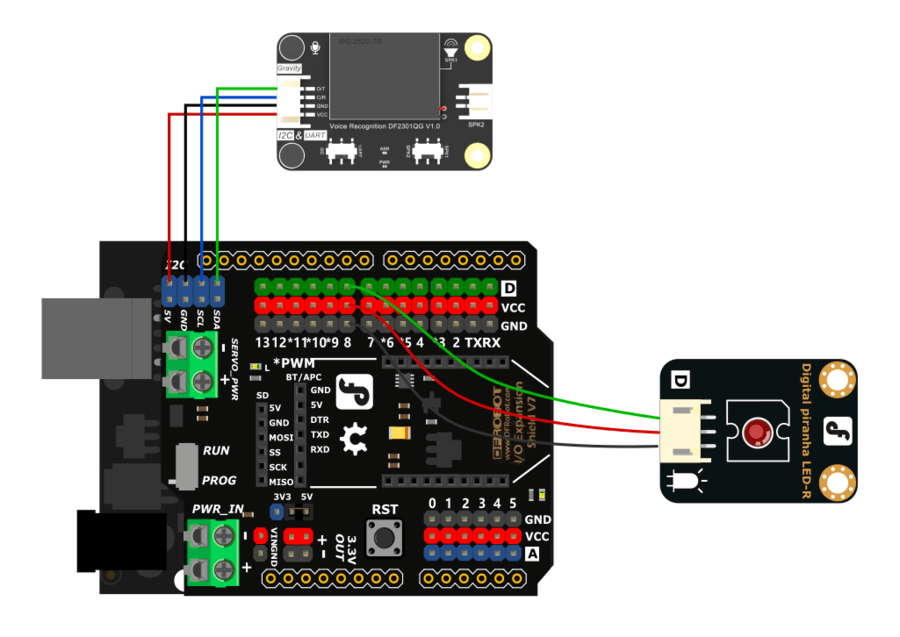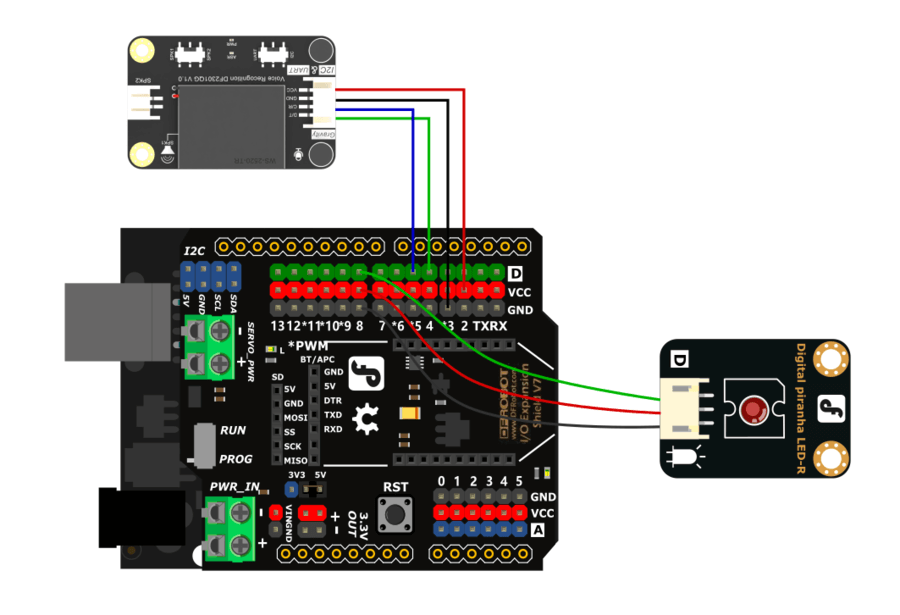Gravity: Offline Language Learning Voice Recognition Sensor for Arduino / Raspberry Pi / Python / ESP32 - I2C & UART (แท้จาก DFRobot)







| รหัสสินค้า | AG30170 |
| หมวดหมู่ | Audio/Sound/MP3/Voice |
| ราคา | 950.00 บาท |
| สถานะสินค้า | พร้อมส่ง |
| จำนวน | ชิ้น |
รายละเอียดสินค้า
INTRODUCTION
|
Pros |
Cons |
|
|
Offline Speech Recognition |
1. Quickly respond to corresponding command words and instructions. 2. No need for a network. 3. If speech recognition fails, it will not affect the use of other product functions. 4. More secure privacy, users don't have to worry about their conversation content being recorded and uploaded to the cloud. 5. Small module size, convenient for embedding in applications. 6. Cheaper price. |
Command words are fixed, and there may be limitations on the number and length of words. |
|
Online Speech Recognition |
1. Consumers are easy to use and not limited to command words. 2. Easy to develop, and there are many solutions in the market. |
1. Requires network connection to connect to the cloud. 2. Response speed depends on the network speed. 3. Higher cost. |


- Self-learning function: Control the module to learn command words by the voice, and any audio can be trained as a command
- Support I2C and UART, with a Gravity interface
- Compatible with 3.3V/5V
- Built-in with 121 commonly-used fixed command words
- The module has a built-in speaker and an interface for an external speaker, which can provide real-time voice feedback on recognition results
- Equipped with power indicator (red) and recognition status indicator (blue)
- Dual microphones provide better noise resistance and longer recognition distance
- Compatible with Arduino controllers: Arduino UNO, Arduino Leonardo, Arduino MEGA, FireBeetle series controllers, Raspberry Pi, ESP32
- Operating Voltage: 3.3 - 5V
- Maximum Operating Current: ≤370 mA (5V)
- Communication: I2C/UART
- I2C Address: 0x64
- Fixed Command: 121
- Fixed Wake-up Command: 1
- Custom Command: 17
- Learning Activation Command: 1
- Onboard Microphone Sensitivity: -28db
- Module Size: 49×32 mm/1.93×1.26”
SHIPPING LIST
- Gravity: Voice Recognition Module - I2C & UART x1
- Gravity-4P I2C/UART Sensor Connector x1
Tutorial
Requirements
- Hardware
- DFRduino UNO R3 (or similar) x 1
- SEN0539 Gravity: Voice Recognition Module x I2C & UART
- Gravity: Digital RED LED Light Module
- Software
- Arduino IDE
- Download and install the DFRobot_DF2301Q Library (About how to install the library?)
Connection Diagram - I2C

Sample Code
Please switch the communication mode switch to the I2C and download the required library file DFRobot_DF2301Q library for the code.
/*!
* @file i2c.ino
* @brief Control the voice recognition module via I2C
* @n Get the recognized command ID and play the corresponding reply audio according to the ID;
* @n Get and set the wake-up state duration
* @copyright Copyright (c) 2010 DFRobot Co.Ltd (http://www.dfrobot.com)
* @licence The MIT License (MIT)
* @author [qsjhyy](yihuan.huang@dfrobot.com)
* @version V1.0
* @date 2022-04-02
* @url https://github.com/DFRobot/DFRobot_DF2301Q
*/
#include "DFRobot_DF2301Q.h"
#define Led 8
//I2C communication
DFRobot_DF2301Q_I2C asr;
void setup() {
Serial.begin(115200);
pinMode(Led, OUTPUT); //Init LED pin to output mode
digitalWrite(Led, LOW); //Set LED pin to low
// Init the sensor
while (!(asr.begin())) {
Serial.println("Communication with device failed, please check connection");
delay(3000);
}
Serial.println("Begin ok!");
/**
* @brief Set voice volume
* @param voc - Volume value(1~7)
*/
asr.setVolume(4);
/**
@brief Set mute mode
@param mode - Mute mode; set value 1: mute, 0: unmute
*/
asr.setMuteMode(0);
/**
@brief Set wake-up duration
@param wakeTime - Wake-up duration (0-255)
*/
asr.setWakeTime(20);
/**
@brief Get wake-up duration
@return The currently-set wake-up period
*/
uint8_t wakeTime = 0;
wakeTime = asr.getWakeTime();
Serial.print("wakeTime = ");
Serial.println(wakeTime);
// asr.playByCMDID(1); // Wake-up command
/**
@brief Play the corresponding reply audio according to the ID
@param CMDID - command word ID
*/
//asr.playByCMDID(23); // Command word ID
}
void loop() {
/**
@brief Get the ID corresponding to the command word
@return Return the obtained command word ID, returning 0 means no valid ID is obtained
*/
uint8_t CMDID = asr.getCMDID();
switch (CMDID) {
case 103: //If the command is “Turn on the light”
digitalWrite(Led, HIGH); //Turn on the LED
Serial.println("received'Turn on the light',command flag'103'"); //Serial transmits "received"Turn on the light",command flag"103
break;
case 104: //If the command is “Turn off the light”
digitalWrite(Led, LOW); //Turn off the LED
Serial.println("received'Turn off the light',command flag'104'"); //The serial transmits "received"Turn off the light",command flag"104""
break;
default:
if (CMDID != 0) {
Serial.print("CMDID = "); //Printing command ID
Serial.println(CMDID);
}
}
delay(300);
}Expected Results
Use a fixed or learned wake-up word to activate the speech recognition module, then speak out "Turn on the light" or "Turn off the light" to control the illumination module.

Connection Diagram - UART

Sample Code
Please switch the communication mode switch to the UART and download the required library file DFRobot_DF2301Q library for the code.
/*!
* @file uart.ino
* @brief Control the voice recognition module via UART
* @n Get the recognized command ID and play the corresponding reply audio according to the ID;
* @n Set the wake-up state duration, set mute mode, set volume, enter the wake-up state, and reset the module
* @copyright Copyright (c) 2010 DFRobot Co.Ltd (http://www.dfrobot.com)
* @licence The MIT License (MIT)
* @author [qsjhyy](yihuan.huang@dfrobot.com)
* @version V1.0
* @date 2022-04-02
* @url https://github.com/DFRobot/DFRobot_DF2301Q
*/
#include "DFRobot_DF2301Q.h"
#define Led 8
/**
@brief DFRobot_URM13_RTU constructor
@param serial - serial ports for communication, supporting hard and soft serial ports
@param rx - UART The pin for receiving data
@param tx - UART The pin for transmitting data
*/
#if (defined(ARDUINO_AVR_UNO) || defined(ESP8266)) // Use software serial
SoftwareSerial softSerial(/*rx =*/4, /*tx =*/5);
DFRobot_DF2301Q_UART asr(/*softSerial =*/&softSerial);
#elif defined(ESP32) // Use the hardware serial with remappable pin: Serial1
DFRobot_DF2301Q_UART asr(/*hardSerial =*/&Serial1, /*rx =*/D3, /*tx =*/D2);
#else // Use hardware serial: Serial1
DFRobot_DF2301Q_UART asr(/*hardSerial =*/&Serial1);
#endif
void setup() {
Serial.begin(115200);
pinMode(Led, OUTPUT); //Init LED pin to output mode
digitalWrite(Led, LOW); //Set LED pin to low
// Init the sensor
while (!(asr.begin())) {
Serial.println("Communication with device failed, please check connection");
delay(3000);
}
Serial.println("Begin ok!");
/**
@brief Reset module
*/
// asr.resetModule();
/**
@brief Set commands of the module
@param setType - Set type
@n DF2301Q_UART_MSG_CMD_SET_VOLUME: Set volume, the set value range 1-7
@n DF2301Q_UART_MSG_CMD_SET_ENTERWAKEUP: Enter wake-up state; set value 0
@n DF2301Q_UART_MSG_CMD_SET_MUTE Mute mode; set value 1: mute, 0: unmute
@n DF2301Q_UART_MSG_CMD_SET_WAKE_TIME ; Wake-up duration; the set value range 0-255s
@param setValue - Set value, refer to the set type above for the range
*/
asr.settingCMD(DF2301Q_UART_MSG_CMD_SET_MUTE, 0);
asr.settingCMD(DF2301Q_UART_MSG_CMD_SET_VOLUME, 7);
asr.settingCMD(DF2301Q_UART_MSG_CMD_SET_WAKE_TIME, 20);
//asr.settingCMD(DF2301Q_UART_MSG_CMD_SET_ENTERWAKEUP, 0);
/**
@brief Play the corresponding reply audio according to the command word ID
@param CMDID - Command word ID
*/
asr.playByCMDID(23);
}
void loop() {
/**
@brief Get the ID corresponding to the command word
@return Return the obtained command word ID, returning 0 means no valid ID is obtained
*/
uint8_t CMDID = asr.getCMDID();
switch (CMDID) {
case 103: //If the command is “Turn on the light”
digitalWrite(Led, HIGH); //Turn on the LED
Serial.println("received'Turn on the light',command flag'103'"); //Serial transmits "received"Turn on the light",command flag"103""
break;
case 104: //If the command is “Turn off the light”
digitalWrite(Led, LOW); //Turn off the LED
Serial.println("received'Turn off the light',command flag'104'"); //The serial transmits "received"Turn off the light",command flag"104""
break;
default:
if (CMDID != 0) {
Serial.print("CMDID = "); //Print command ID
Serial.println(CMDID);
}
}
delay(300);
}
Expected Result
Use a fixed or learned wake-up word to activate the speech recognition module, then speak out "Turn on the light" or "Turn off the light" to control the illumination module.







วิธีการชำระเงิน
ชำระเงินค่าสินค้าโดยการโอนเงินเข้าบัญชีธนาคาร KBANK, SCB, BBL,TMB
กรุณาเก็บหลักฐานการโอนเงินของท่านไว้เพื่อแจ้งการชำระเงินด้วยค่ะ
ท่านสามารถแจ้งการชำระเงินผ่านระบบอัตโนมัติได้โดย Click Link ข้างล่างค่ะ
https://www.arduitronics.com/informpayment
ชำระเงินผ่านธนาคาร
สินค้าที่เกี่ยวข้อง
SEARCH
CATEGORY
CONTACT US
Join เป็นสมาชิกร้านค้า
STATISTICS
| หน้าที่เข้าชม | 15,458,960 ครั้ง |
| ผู้ชมทั้งหมด | 5,962,038 ครั้ง |
| เปิดร้าน | 21 พ.ค. 2556 |
| ร้านค้าอัพเดท | 1 พ.ย. 2568 |
TRACK&TRACE
MEMBER
- ระดับ{{userdata.dropship_level_name}}
- ไปหน้าหลักตัวแทน
- ทั้งหมด {{(order_nums && order_nums.all)?'('+order_nums.all+')':''}}
- รอการชำระเงิน {{(order_nums && order_nums.wait_payment)?'('+order_nums.wait_payment+')':''}}
- รอตรวจสอบยอดเงิน {{(order_nums && order_nums.wait_payment_verify)?'('+order_nums.wait_payment_verify+')':''}}
- รอจัดส่งสินค้า {{(order_nums && order_nums.wait_send)?'('+order_nums.wait_send+')':''}}
- รอยืนยันได้รับสินค้า {{(order_nums && (order_nums.wait_receive || order_nums.wait_confirm))?'('+(order_nums.wait_receive+order_nums.wait_confirm)+')':''}}
- รอตรวจสอบข้อร้องเรียน {{(order_nums && order_nums.dispute)?'('+order_nums.dispute+')':''}}
- เรียบร้อยแล้ว {{(order_nums && order_nums.completed)?'('+order_nums.completed+')':''}}
- ทั้งหมด {{(order_nums && order_nums.all)?'('+order_nums.all+')':''}}
- รอการชำระเงิน {{(order_nums && order_nums.wait_payment)?'('+order_nums.wait_payment+')':''}}
- รอตรวจสอบยอดเงิน{{(order_nums && order_nums.wait_payment_verify)?'('+order_nums.wait_payment_verify+')':''}}
- รอจัดส่งสินค้า {{(order_nums && order_nums.wait_send)?'('+order_nums.wait_send+')':''}}
- ส่งสินค้าเรียบร้อยแล้ว {{(order_nums && order_nums.sent)?'('+order_nums.sent+')':''}}





